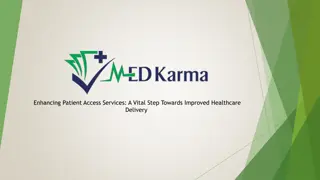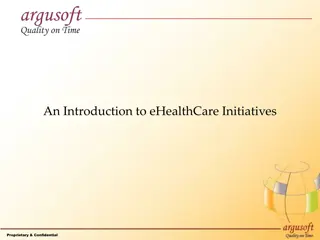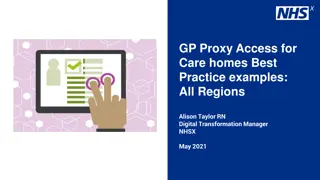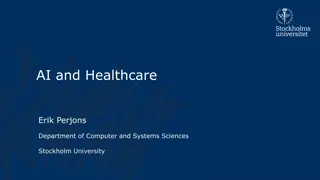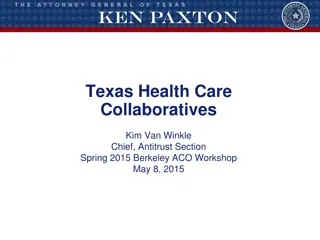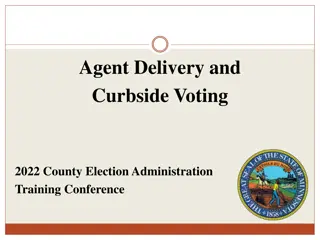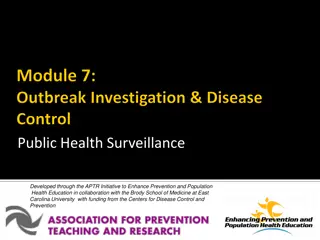Overview of US Healthcare Delivery Systems Developed through the APTR Initiative
The US Healthcare Delivery Systems were developed through the APTR Initiative to enhance prevention and population health education in collaboration with the Brody School of Medicine at East Carolina University. The module acknowledges key individuals involved and is made possible through funding from the Centers for Disease Control and Prevention. It delves into major sectors of the US healthcare system and describes interactions among clinical practice, public health, organization of public health systems, impact on special populations, and oversight entities influencing US health system policy.
Download Presentation

Please find below an Image/Link to download the presentation.
The content on the website is provided AS IS for your information and personal use only. It may not be sold, licensed, or shared on other websites without obtaining consent from the author. Download presentation by click this link. If you encounter any issues during the download, it is possible that the publisher has removed the file from their server.
E N D
Presentation Transcript
US Healthcare Delivery Systems Developed through the APTR Initiative to Enhance Prevention and Population Health Education in collaboration with the Brody School of Medicine at East Carolina University with funding from the Centers for Disease Control and Prevention
APTR wishes to acknowledge the following individuals that developed this module: Joseph Nicholas, MD, MPH University of Rochester School of Medicine Anna Zendell, PhD, MSW Center for Public Health Continuing Education University at Albany School of Public Health Mary Applegate, MD, MPH University at Albany School of Public Health Cheryl Reeves, MS, MLS Center for Public Health Continuing Education University at Albany School of Public Health This education module is made possible through the Centers for Disease Control and Prevention (CDC) and the Association for Prevention Teaching and Research (APTR) Cooperative Agreement, No. 5U50CD300860. The module represents the opinions of the author(s) and does not necessarily represent the views of the Centers for Disease Control and Prevention or the Association for Prevention Teaching and Research.
1. List the major sectors of the US healthcare system 2. Describe interactions among elements of the healthcare system, including clinical practice and public health 3. Describe the organization of the public health system at the federal, state, and local levels 4. Describe the impact of the healthcare system on special populations 5. Describe roles and interests of oversight entities on US health system policy
Quality Access Cost (Often) competing goals
Who currently utilizes health care in the US? Where do most healthcare encounters occur? What is the reason for most encounters? What are the different models for organizing, funding and regulating these encounters? How do public health and clinical practice influence one another?
1.2 billion ambulatory visits per year (2008) Children - routine health check and respiratory infections Young women - pregnancy, gynecologic care Adults (both sexes) - hypertension, ischemic heart disease, and diabetes mellitus 35 million hospital discharges (2006) Average length of stay - 4.8 days 46 million procedures performed National Center for Health Statistics 2008
Regulation of commerce Control entry of persons to US Control inspection/entry of products to US and across state lines Funding of public health programs Provision of care for special populations Coordination of federal agencies
Community health assessment Public health policy development Assurance of public health service provision to communities Continuity between federal public and local public health Conduit for funding Linkage of resources to needs
May be city and/or county-based Provide mandated public health services Enact and enforce public health codes as mandated by state and federal officials Must meet minimum threshold of state standards May be more rigorous than state standards
Vital statistics Communicable disease control Maternal and child health Environmental health Health education Public health laboratories
Clinical Medicine Patient-focused Diagnosis and treatment Medical care paradigm Public Health Population-focused Disease prevention and health promotion Spectrum of interventions
Types of Healthcare Services Delivery Settings Preventive Care Public Health Programs Community Programs Personal Lifestyles Physician Office/Clinic Self-Care Alternative Medicine Specialist Clinics Primary Care Settings Specialist Provider Clinics Home Health Long-term Care Facilities Self-Care Alternative Medicine Primary Care Specialized Care Chronic Care Shi & Singh 2008
Types of Healthcare Services Delivery Settings Long-term Care Long-term Care Facilities Home Health Sub-Acute Care Special Sub-Acute Units (Hospital, Long-term Care Facilities) Home Health Outpatient Surgical Centers Hospitals Rehabilitation Departments (Hospital, Long- Term Care Facilities) Home Health Outpatient Rehabilitation Centers Hospice Services Acute Care Rehabilitative Care End-of-Life Care Shi & Singh 2008
Typically address acute, chronic, preventive/wellness issues Coordinate specialty care when needed Providers are typically generalists (MD/DO/NP/PA) Primary care specialties : Family Medicine, General Internal Medicine, Pediatrics, Obstetrics-Gynecology Develop ongoing patient-provider relationship Multiple settings: provider offices, clinics, schools, colleges, prisons, worksites, home, mobile vans
Typically subspecialty care focused on a particular organ system or disease process Available in most communities Includes common inpatient and outpatient services Subspecialty office care Inpatient care including emergency care, labor and delivery, intensive care, diagnostic imaging
Consultative subspecialty care Typically provided at large regional medical centers Characterized by advanced technology and high volume of procedures Tertiary care sites usually serve as major education sites for students in a variety of health professions
Tertiary Medical Care Relative Investment Tertiary Prevention Secondary Medical Care Primary Medical Care Secondary Prevention Clinical Preventive Services Primary Prevention 2% of $$ Population Oriented Prevention
Personnel Healthcare institutions US Public Health Service Commissioned Corps Drug and device manufacturers Education and research
Nurses Physicians (MD/DO) NP,PA, midwives Pharmacists Dentists Several million ancillary personnel 80% involved in direct healthcare provision Therapists, social workers, lab technicians National Center for Health Statistics 2004
Traditional solo practitioner model is fading Most providers join larger groups Private, physician-owned groups Health system owned groups (networks) Health maintenance organizations Preferred provider organizations
Private, community hospitals Not for profits are most common Many are religiously affiliated Private, for profit Public (state or local government) Psychiatric hospitals Academic medical centers VA and military centers
Long term care facilities Nursing homes/skilled nursing facilities Assisted living facilities* Enhanced care facilities* Adult homes* Rehabilitation facilities Physical rehabilitation Substance abuse facilities *These residential long-term care facilities are not really healthcare institutions but commonly referred to as such.
6,600 full time clinical and public health professionals Provide primary care in underserved areas Staff domestic and international public health emergencies Work in research, administrative and public health capacities in a number of federal agencies
Large industry with major impact on cost and policy $234 billion in 2008 Growing rapidly with the passage of Medicare D (prescription benefit) Regulated by Food and Drug Administration Hartman et al 2010
Public/Private funding mix supports undergraduate nursing, medical and physician assistant programs Public funding of Graduate Medical Education US does not actively manage specialty choice or distribution of its physician workforce Government is major funder for basic medical research Industry is major funder for clinical trials of drugs, and devices and continuing medical education
Diverse set of regulators Government (state, federal, local) Insurers Hospitals Private accrediting bodies Professional societies
Quality Access Cost (Often) competing goals
Most healthcare regulation comes from states Licensure and oversight of medical facilities and providers Control distribution of services through certificate of need process Regulate insurance coverage Mandate minimum standards Regulate cost, scope of coverage and exclusion criteria
Purpose Cost containment Prevent unnecessary duplication of health care Ensure high quality health services Accomplishes this through many roles Extensive review process
Regulatory power derived from federal status as the major payor in most systems (Medicare, Medicaid) Reimbursement is increasingly tied to compliance with federal standards Department of Health and Human Services (DHHS) is the major federal actor in healthcare regulation
DOD DHHS VA CDC CMS SAMHSA HRSA IHS FDA
Contract with physicians/hospitals to encourage Quality Cost control Market share Set standards Audit providers and institutions Adjust payments accordingly
Credential physicians, physician assistants, midwives, nurses, other healthcare staff Hospital credentialing often necessary for malpractice insurance eligibility Regular review of medical staff for quality, professional conduct and practice standards
JCAHO (Joint Commission on Accreditation of Healthcare Organizations) Accredits hospitals Private organization of member hospitals NCQA (National Committee for Quality Assurance) Accredits managed care plans Private organization representing employers/purchasers Specialty Organizations Specific certifications (bariatric surgery centers, Baby Friendly USA)
Historically the major regulator of healthcare delivery until increasing influence of government and insurance industries Still influential in determining acceptable professional practice standards, and contributing to regulatory policy
Most common impairments Substance abuse/dependency Mental illness Aging-related impairments a growing problem Trend toward treatment vs. sanction
Unique health care infrastructure Inter-generational health care needs Health/public health considerations War-related injuries Chemical exposure Homelessness Post traumatic stress disorder Prisoners of war
Created through treaties between US government and Indian tribes Eligibility for US benefits and programs Contract Health Services (CHS) to supplement Considerations for American Indians Safe water and sewage Injury mortality rate 2-4x other Americans
K-12 Student Health Centers Medical, psychosocial, preventive care for all Age appropriate health education College Student Health Center Medical and preventive care for all Campus health emergencies
Privatization and telemedicine are growing trends to meet prisoner healthcare needs Unique considerations Injuries, infectious diseases, and substance abuse very prevalent > 50% of inmates suspected to have mental illness Aging in prisons Must address barriers to health care secure escort
Considerations Intellectual/Developmental Disabilities (I/DD)- specific clinic or integrated health care Consent capacity Surrogate Decision Making Committees Guardianship Diagnostic, treatment challenges Caregiver perspectives on health concerns
Strengths Advanced diagnostic and therapeutic technology Timely availability of subspecialists and procedures
Weaknesses Limited access to multiple underserved populations High cost with marginal population outcomes Fragmentation of care Insufficient primary care workforce Highly bureaucratic/large administrative costs Misaligned incentives








